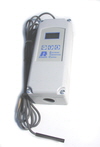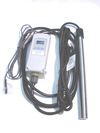|
NOTES on electrically heating larger aquariums or central systems:
Large aquariums or Central Filtration systems with Sumps can benefit from using heaters with a separate controller. Considering an average of 4
watts per gallon minimum requirement, one 300 watt heater would not be adequate to keep a 90 gallon aquarium at 80 degree F. In fact any aquarium 48 or longer can benefit from having 2 smaller heaters on opposite
ends.
Perfectly synchronizing both heaters’ thermostats can be problematic at best, if not impossible. Conventional aquarium heaters are made primarily for low cost sales appeal. The integrated thermostats
are not very accurate nor reliable, but the primary problem occurs with regards to the setpoint and the differential built into all thermostats. The differential is the difference between the turn on setting and the
turn off setting. This prevents the heaters from turning on and off rapidly (cycling), in response to small changes in temperature. This setting can be between 1/2 and 2 degrees and when installing multiple heaters
within the same body of water it becomes impossible for both these thermostats to operate identically.
As an example of problems related to setpoint variance: An 100
gallon aquarium with (2) 200 watt heaters on opposite ends of the tank. One heater senses the temperature drop to 77 F and turns on, beginning to heat the water. Meanwhile the other heater has not yet turned on and
may not since the turn on temperature setting may not be exactly the same. Or the water could be very slightly warmer where this heater is, preventing this heater from ‘seeing’ its turn on temperature.
As the first heater begins to heat the water, the second is much less likely to turn on now, since the turn on temp setting is slowly being exceeded. This leaves the first heater doing most of the work to bring up
the tank’s temperature and reach its turn off setting. It most likely will have difficulty just maintaining the tank’s temp., since one 200 watt heater may not be adequate for an 100 gallon aquarium. The
second heater may eventually turn on, but not before the first heater has been on for an extended period.
An example of thermostat differential problems: Consider a
situation where 2 heaters manage to be on at the same time, then one heater reaches its turn off setting first either due to slightly different differentials, inaccuracies in the thermostats, or slight water temp
fluctuations. The remaining heater is now doing all the work trying to reach its turn off setting. It is struggling to maintain temperature in the tank. The second heater does not turn on yet since the required
differential has not been reached. (turn on setting is below what the second heater, by being on is allowing the tank’s temp. to fall to) it may stay on for hours in this mode before the desired temp. is
reached or the other heater switches on!
The larger the aquarium, the more heaters required, the more problems with synchronizing occur. Many larger aquariums with multiple heaters will have at least one heater
operating at long intervals, sometimes always on. This puts a lot of wear on the heater, increasing the likelihood that it will fail at some point. With all heaters properly synchronized, the service life of
aquarium heaters will be much longer. This is only possible by using a separate controller. All of the heaters are adjusted to their highest setting, (permanently on) and all plugged into a power strip type adapter.
This is then connected to the output of the controller, thereby effectively bypassing the heaters’ thermostats.
The problems with synchronization can be exacerbated when multiple heaters are placed in a
sump, as is common on larger aquariums with Wet-Dry filtration systems. Consider the high wattage requirements of a 180 gallon aquarium with a sump size of maybe 30 gallons. Even with a flow rate of 1200 GPH through
the filter the proximity of the heaters to each other is so very close that the likelihood they all operate concurrently is even more remote than if they were placed directly in the aquarium. The need for a separate
controller is strongly indicated in this configuration.
With properly synchronized heaters, the actual on time for heating the aquarium is much less, thereby providing less wear on individual heaters. The cost
savings in electricity usage alone may pay for the price of the controller in a short time.
The use of a Temperature Control device with a remotely mounted sensor, provides much better aquarium temperature
maintenance. The sensor can be mounted unobtrusively anywhere needed in the aquarium. Near the filter intake or even within the overflow box, however we recommend always keeping the sensor in the same body of water
as where the heaters are located to avoid a situation where water is not moving due to a water pump stoppage or leak in plumbing. Sensor would be calling for heat yet the heaters are boiling away in the separate
sump!
Adjustments to the tank’s water temperature is done much easier than without a controller. (Imagine trying to raise the settings equally on 4 or 5 individual heaters) By using this
controller in conjunction with higher quality Aquarium heaters such as Ebo-Jager or our large Titanium Heaters will provide the aquarium with a reliable system for maintaining proper temperature control at a fraction of the cost of other set-ups such as Industrial type Immersion Heaters and high wattage inline heater modules. This controller can alternatively operate a chiller or be wired in series with the chiller’s control to prevent both from operating at the same time
|










